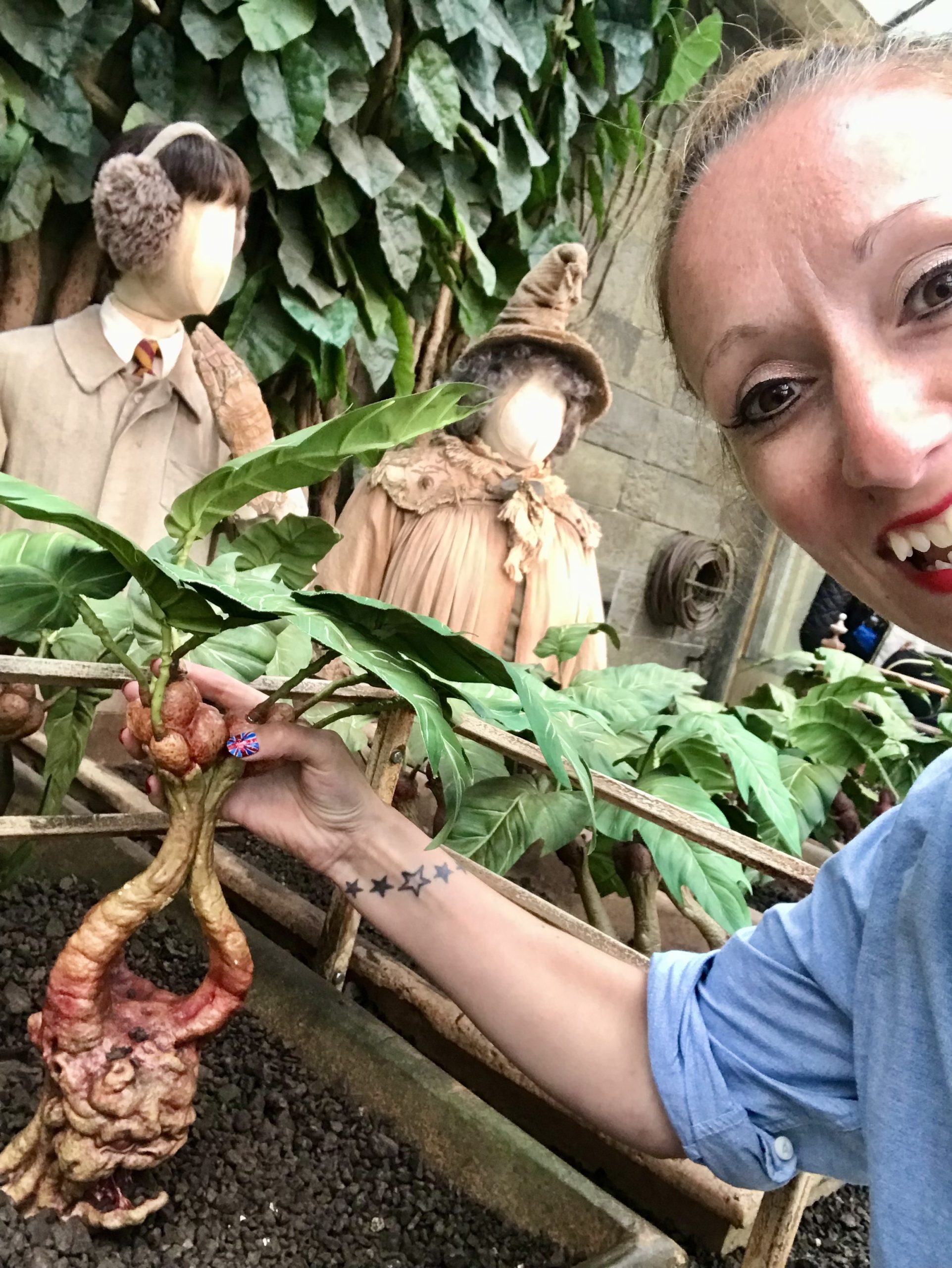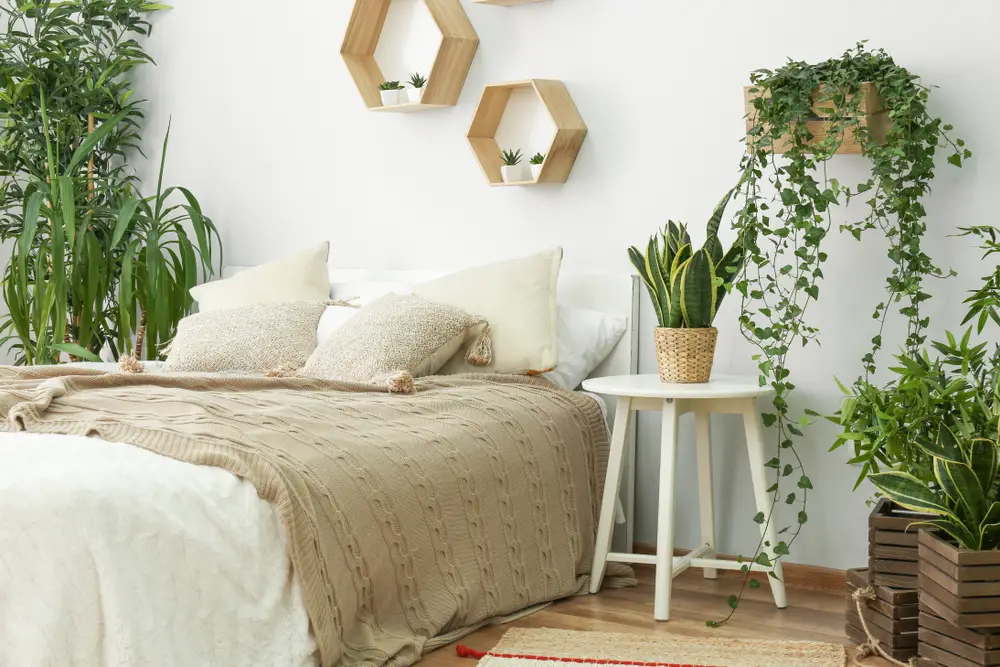If you’re interested in improving your home’s air quality while adding a touch of greenery to your space, we’ve got you covered!
Indoor plants are known for their excellent ability to enhance air quality by producing oxygen and removing pollutants. From easy-to-care-for succulents to elegant ferns, each plant has its own set of benefits.
Here, we’ll cover 15 of the best Indoor plants for oxygen production. You’ll also find everything you need to know to care for these oxygen-producing houseplants so that they can thrive in your home and help you breathe better!
Let’s start with a little light science on how houseplants improve air quality!
How Photosynthesis Helps Plants Give Off Oxygen

Photosynthesis is the process that plants use to make their own food and it also produces oxygen. The plants take in sunlight through a green pigment in their leaves called chlorophyll. Absorbing this light provides the energy needed to convert carbon dioxide (the gas they take in from the air) and water (absorbed through their roots) into glucose. This is a type of sugar that serves as food for the plant. During photosynthesis, oxygen is released as a byproduct. The plants release the converted oxygen through little openings in the leaves called stomata.
In indoor spaces, photosynthesis plays a key role in improving air quality. This is why houseplants are a great addition to any home. By absorbing carbon dioxide and releasing oxygen, plants help increase oxygen levels, making the air fresher and more invigorating. This not only enhances the comfort of your home but also offers many health benefits and supports better overall well-being.
The Best Houseplants For Improving Indoor Air Quality
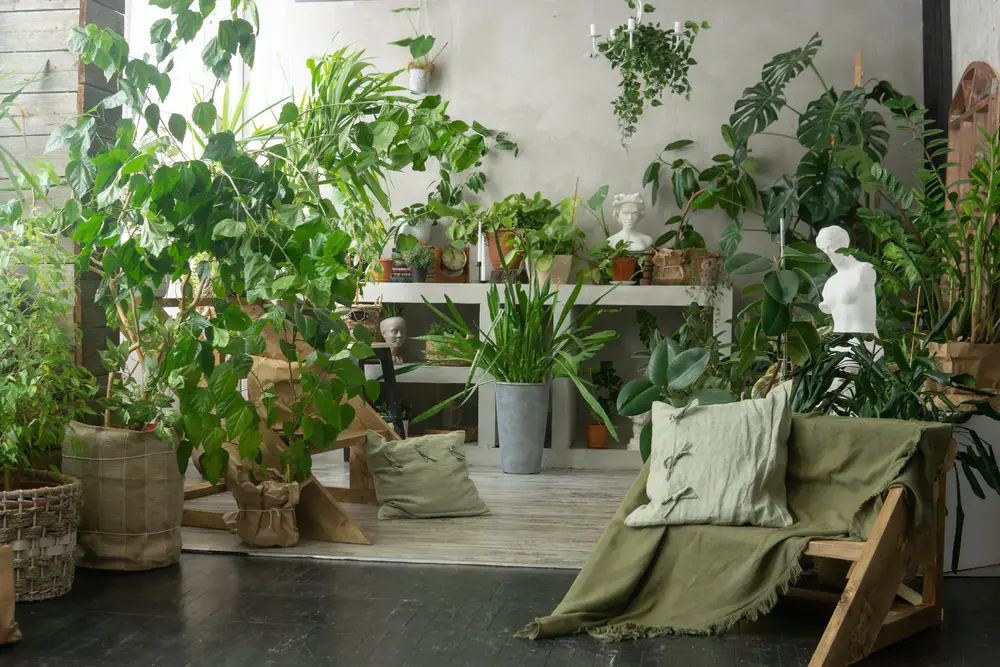
Oxygen-producing plants are more than just beautiful additions to your home; they play a crucial role in enhancing indoor air quality.
As we know, plants absorb carbon dioxide and release oxygen through photosynthesis, however, their benefits extend beyond oxygen production.
Some plants, such as spider plants, peace lilies, and snake plants, also absorb and neutralize harmful toxins like formaldehyde, benzene, and carbon monoxide from the air.
We often unknowingly bring these toxins into our homes via common household items like furniture, cleaning products, and paints. An accumulation of these toxins can impact our air quality and overall health.
So when you incorporate air-purifying plants into your home, you can reduce the concentration of these harmful toxins, thus improving your air quality and health.
The benefit of these plants is two-fold: they produce oxygen and purify the air. Which makes them a valuable addition to any home!
Why Oxygen-Producing Plants Are Perfect For Bedrooms

Did you know that some oxygen-producing plants significantly enhance the quality of your sleep? This is why it is good to place them in your bedroom.
Most plants release oxygen during the day, but some varieties, such as the Snake Plant and Gerbera Daisy, continue this process through the night.
The Snake Plant, in particular, has the ability to photosynthesize all day and night. So it is a great choice in the bedroom for improved air quality while you sleep.
Equally, the Gerbera Daisy is another great choice. Its presence in the bedroom offers a continuous supply of oxygen which contributes to a fresher atmosphere and better sleep quality. Plus its vibrant blooms are a beautiful addition to any bedroom setting.
Incorporating these plants into your bedroom can help create a more restful and rejuvenating sleep environment.
How To Care For Oxygen-Producing Plants
Get to know the specific needs of each of your plants. Every plant is different. Some like low-light conditions, while others need lots of sun. Some are good in small spaces, others can eventually grow quite large and take up a lot of space. Certain ones need lots of water, others not so much.
Please see the detailed information tables below for the requirements and guidelines for each specific plant.
Safety Considerations For Pets And Children
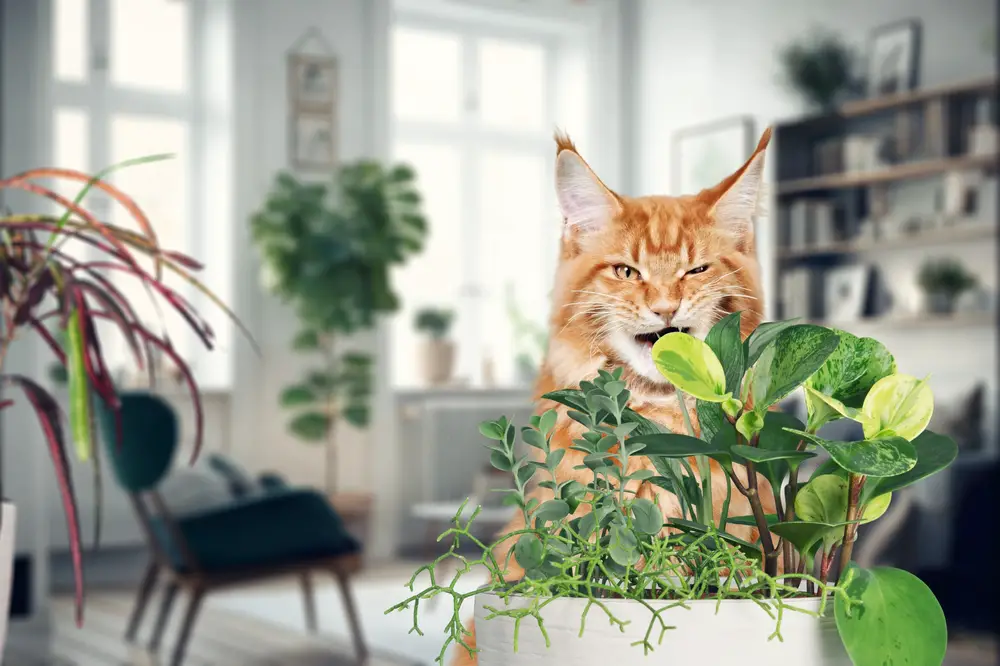
At Gardenia Organic, we strive to provide helpful information on a variety of plants and their benefits. When incorporating any plants into your home, it’s important to consider the safety of your pets, as some plants can be toxic if ingested.
For the health of your pets (and plants!), we suggest locating your houseplants in locations that are less accessible to curious animals.
While we offer guidance and information, we encourage you to research each plant’s safety so you can make informed decisions. Always monitor your pets around houseplants, take precautions to ensure their well-being, and consult with a veterinarian if you have any concerns.
Naturally, the same cautions apply in homes with small children, who are often drawn to the colors and shapes of houseplants. Keep plants out of reach of curious little hands. If you’re unsure about having plants in your home, consult your family doctor.
Your family’s safety is our priority, so do some research and educate yourself about each plant’s possible risks. Then you can enjoy your indoor greenery while keeping your children and pets safe and happy.
Common Problems And Solutions For Oxygen-Producing Plants
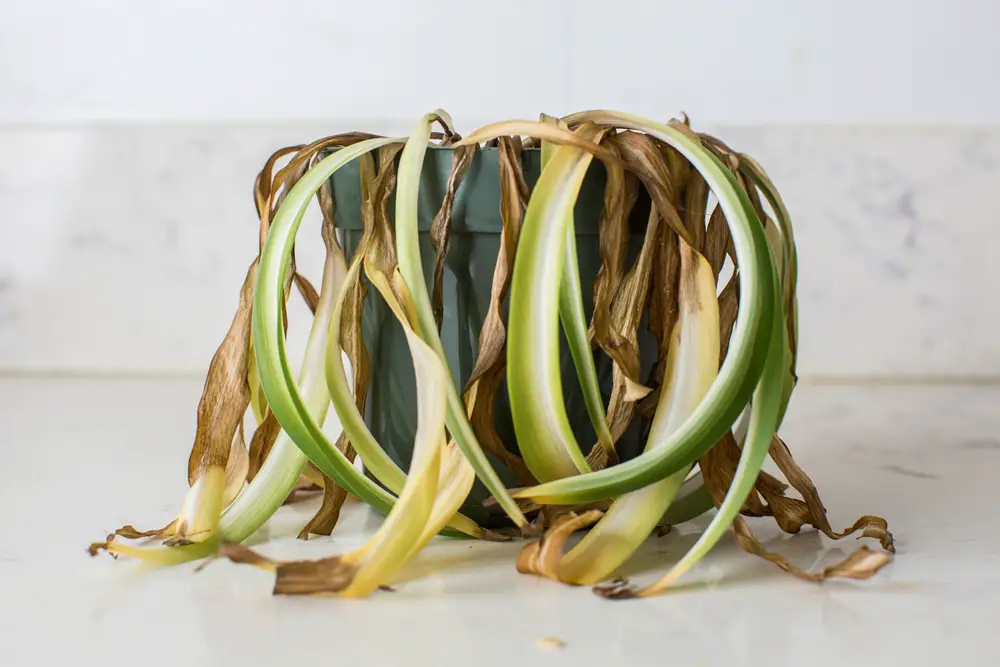
Indoor plants of all sorts suffer from common challenges. Some are caused by environmental conditions (e.g. dry air, low light, too much water, not enough nutrients). Others are the result of insect pests or diseases.
See below for some troubleshooting tips on common problems.
| Sign | Problem | Solution |
|---|---|---|
| Droopy-looking leaves | Too much water / Too little water | For most plants, water when top 1 inch (2.5 centimeters) is dry |
| Leaves with brown tips | Too dry / Too much fertilizer | Use a spray bottle to mist plantReduce feeding. Mix half the concentration and use it twice as often |
| Yellow leaves | Watering issue / Not enough light | Water when top 1 inch (2.5 centimeters) is dryRelocate to a position of bright indirect sunlight |
| Bottom leaves yellow | Lack of Nitrogen (N) | Apply a houseplant fertilizer to provide some nitrogen |
| Yellow leaves on one side | Too much sun | Relocate plant out of direct sunlight |
Pests
| Problem | Signs and Symptoms | Solution |
|---|---|---|
| Spider Mites | Leaves turn speckled yellow (like spray paint), dry up and curl. Fine webs are visible on underside of leaves and on growth tips. Tiny mites are barely visible crawling on underside of leaves and in webbing | Wipe down all leaves with damp cloth. For severe cases, apply a commercial insecticidal soap product. Spray undersides of leaves and wherever there are webs.To prevent infestations, maintain high humidity around plants. |
| Aphids | New shoots and young leaves curl & turn yellow. Leaves may be covered with sticky coating.Aphids will cluster on new growth tips | For mild cases, wipe plant parts to squish aphids. Repeat every few days.For heavy infestations, prune off plant tips. Apply a commercial insecticidal soap product, spraying directly onto aphids. |
| Mealybugs | Leaves curl and turn yellow. Cotton-like white tufts are visible on underside of leaves and at leaf nodes on the stems | Using a cotton swab dipped in rubbing alcohol, carefully dab the clusters of insects. Apply a commercial insecticidal soap product. Spray directly on fluffy clusters. |
| White fly | Tiny white moth-like flies flutter around when plant is disturbed.Mottled yellow leaves with distorted growth. Sticky honeydew on foliage. | Hang yellow sticky-trap cards (one or two cards per plant) around infested plants at first sign of white flies to trap adults. Apply a commercial insecticidal product listed for white fly. Flies must be sprayed directly to be effective and repeat applications are usually necessary |
| Soft brown scale | Young leaves are pale and stunted. Scales are found on stems and along the centre vein on the underside of leaves.Black sooty mold may appear on leaves | Wipe scale off leaves and stems using a cotton swab dipped in rubbing alcohol. |
| Soil Gnats | Don’t pose a problem for plant health but can be a nuisance flying around plants | Allow top two inches (5 cm) of soil to dry out between waterings. Cover the soil surface with a half-inch (2 cm) layer of coarse sand or kitty litter |
15 Air-Purifying Houseplants That Give Off The Most Oxygen
Here’s our top 15 plants that give off the most oxygen:
1. Aloe Vera (Aloe barbadensis miller)
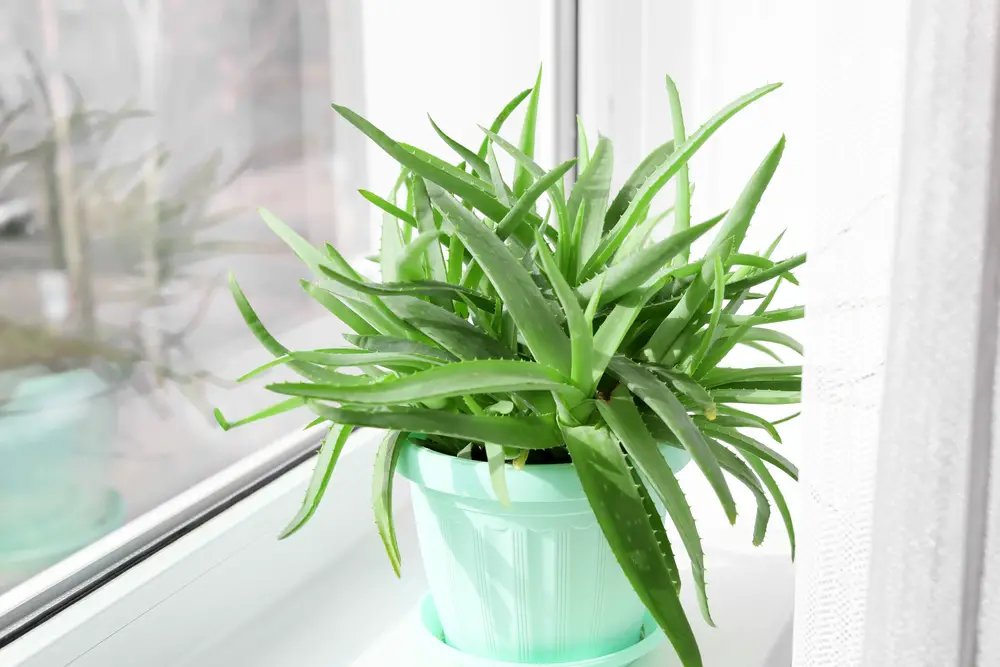
| Origin | Africa, Madagascar, and Arabian Peninsula |
| Plant size | 12-24 inches (30-60 centimeters) in height and width |
| Flowering | Rarely flowers indoors |
| Light | Bright indirect sun, can tolerate some direct sun |
| Watering | Water when the top inch (2.5 centimeters) of soil has dried out. Allow plant to dry out between waterings |
| Fertilizer | Feed every 4-6 weeks during the growing season (spring and summer) with a balanced, water-soluble fertilizer |
| Potting soil | Well-draining potting mix or a mix designed for cacti and succulents |
| Pruning | Remove any dead or damaged leaves at the base to encourage new growth |
| Repotting | Repot every 2-3 years |
| Toxicity | Generally non-toxic to pets and humans, but can cause mild gastrointestinal upset if ingested in large amounts |
Aloe vera is a fantastic choice for improving indoor air quality while requiring minimal upkeep. This resilient plant not only enhances oxygen levels by releasing oxygen through photosynthesis, but it also absorbs carbon dioxide, making the air in your home fresher.
Known for its low-maintenance needs, aloe vera thrives with infrequent watering and can adapt to various light conditions. Additionally, it helps filter out toxins like formaldehyde and benzene from the air, further contributing to a healthier indoor environment.
Its ease of care and air-purifying benefits make aloe vera an excellent addition to any space looking to boost air quality effortlessly.
In addition to oxygen production, aloe vera also has many medicinal qualities. The gel inside the leaves is great for skin irritations such as burns, cuts, and sunburn. It is widely used for its moisturizing and healing benefits.
2. Boston Fern (Nephrolepis exaltata)
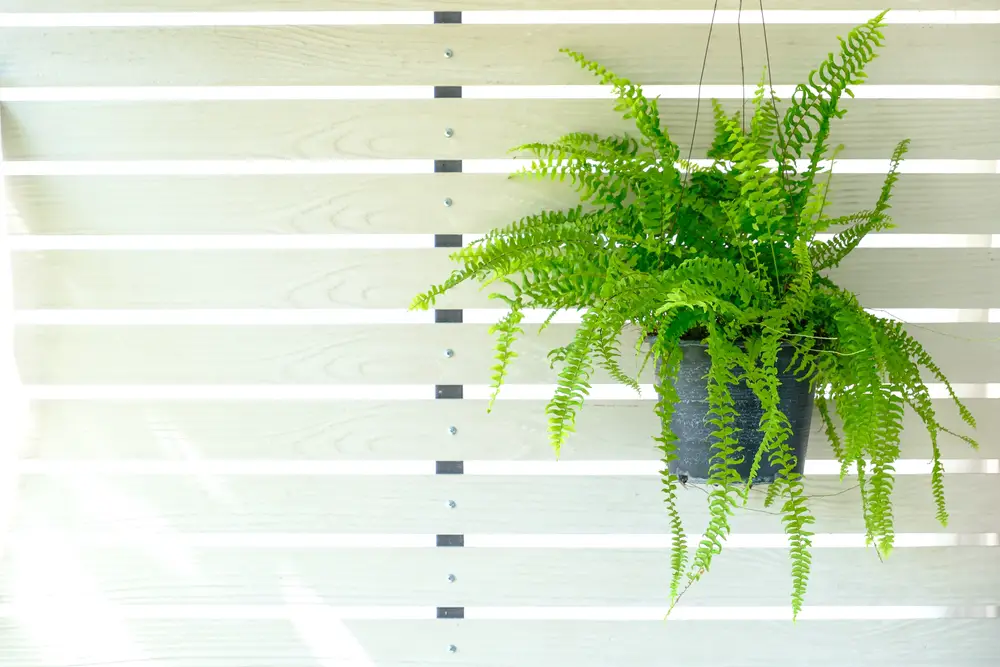
| Origin | Central and South America |
| Plant size | 12-36 inches (30-90 cm) in height and width |
| Flowering | N/A |
| Light | Bright, indirect light; can tolerate low light but not direct sunlight |
| Watering | Keep soil evenly moist. Water when the top inch (2.5 centimeters) of soil has dried out |
| Fertilizer | Feed every 4-6 weeks during spring and summer. |
| Potting soil | Rich, well-draining potting mix |
| Pruning | Trim off brown or dead fronds |
| Repotting | Repot every 1-2 years or when the plant becomes root-bound. Repot in spring |
| Toxicity | Non-toxic to pets and humans |
Boston Ferns are highly effective in enhancing indoor air quality, especially in environments with elevated humidity levels, such as bathrooms.
This plant is noted for its substantial oxygen production. Additionally, the Boston Fern plays a significant role in purifying the air by removing pollutants such as formaldehyde and xylene.
Its natural preference for high-humidity conditions makes it the perfect choice for the typical moisture levels found in bathrooms.
3. Spider Plant (Chlorophytum comosum)
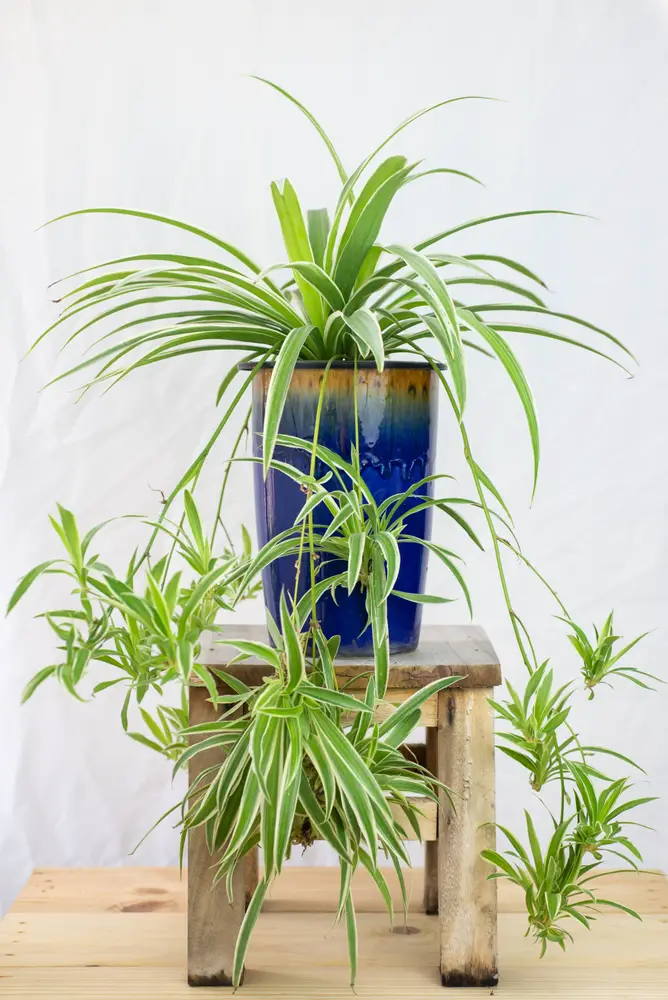
| Origin | South Africa |
| Plant size | 12-24 inches (30-60 cm) in height, with a similar spread |
| Flowering | Rarely flowers indoors |
| Light | Prefers bright, indirect light but can tolerate low light |
| Watering | Water when the top inch (2.5 centimeters) of soil feels dry; avoid overwatering |
| Fertilizer | Feed monthly during the growing season (spring and summer) with a balanced, water-soluble fertilizer |
| Potting soil | Well-draining potting mix, such as a mix for houseplants |
| Pruning | Trim off brown tips and dead or damaged leaves to maintain appearance and promote new growth |
| Repotting | Repot every 1-2 years or when the plant becomes root-bound; typically done in spring |
| Toxicity | Non-toxic to pets and humans |
Spider plants are a superb choice for enhancing indoor air quality with minimal effort. Renowned for their ability to absorb carbon monoxide and other impurities, they effectively cleanse the air while continuously releasing oxygen.
Their rapid growth rate makes them an appealing option for those looking to see quick results.
Moreover, spider plants are pet-friendly, providing a safe environment for your furry friends while contributing to a fresher, healthier living space.
4. Heartleaf Philodendron (Philodendron hederaceum)
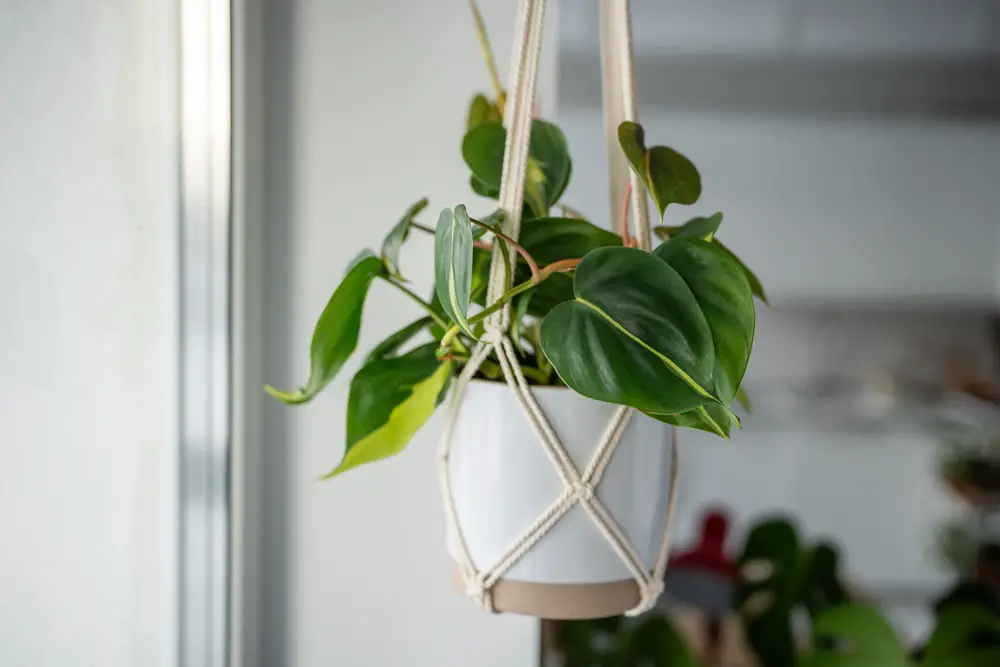
| Origin | Central and South America |
| Plant size | 12-24 inches (30-60 centimeters) in height; can trail or climb up to 3-4 feet (90-120 centimeters) |
| Flowering | N/A |
| Light | Bright indirect sun, can tolerate low light |
| Watering | Water when the top inch (2.5 centimeters) of soil has dried out. Avoid overwatering |
| Fertilizer | Feed every 4-6 weeks during spring and summer |
| Potting soil | Well-drained potting mix |
| Pruning | Trim any leggy growth and remove any yellow or damaged leaves |
| Repotting | Repot every 1-2 years |
| Toxicity | Toxic to people and pets if ingested |
The heart-shaped leaves not only add a beautiful touch to any space but also play a significant role in improving air quality. It is an exceptional plant for absorbing carbon dioxide and releasing oxygen.
This plant’s ability to effectively filter out indoor pollutants while increasing oxygen levels makes it a valuable addition to any home.
The Heartleaf Philodendron is one easy-going plant! It is remarkably easy to care for and can withstand minimal attention. It adapts well to various light conditions and has a very forgiving nature with infrequent watering. So it is a great choice for beginners or those with busy lifestyles.
5. Gerbera Daisy (Gerbera jamesonii)
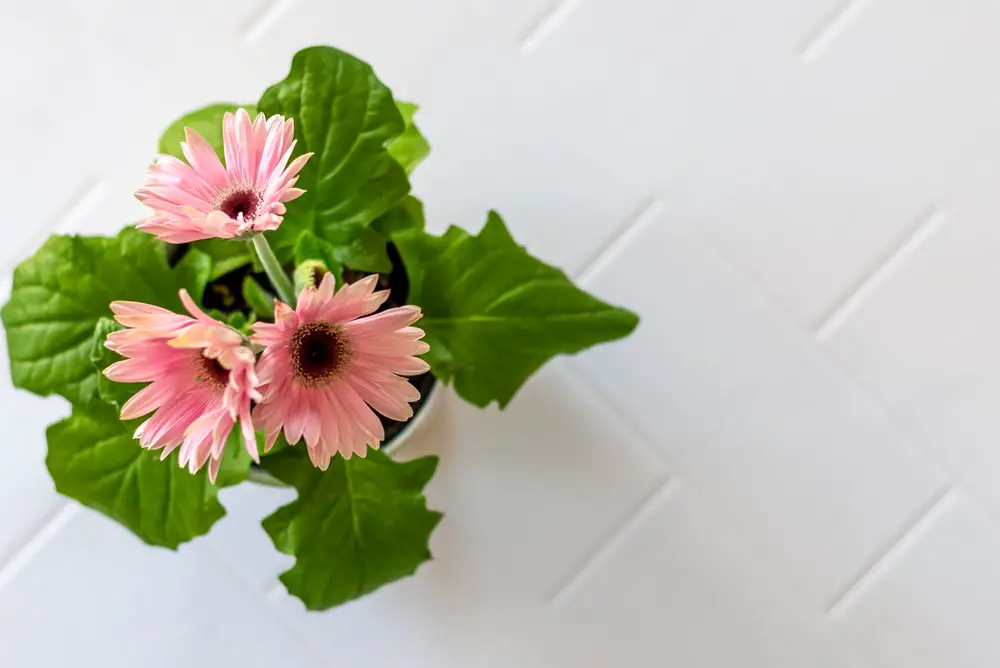
| Origin | South Africa, Madagascar, Tropical Asia |
| Plant size | 6-18 inches (15-45 centimeters) in height; 12-18 inches (30-45 centimeters) in width |
| Flowering | Spring through fall, potentially year-round indoors |
| Light | Bright indirect sun |
| Watering | Keep soil evenly moist when flowering but not soggy. Water when the top inch (2.5 centimeters) of soil has dried out |
| Fertilizer | Feed every 4-6 weeks from spring to fall |
| Potting soil | Well-drained potting mix or mix for flowering plants |
| Pruning | Remove spent flowers and dead foliage to encourage new blooms |
| Repotting | Repot every 1-2 years |
| Toxicity | Non-toxic to pets and humans |
Gerbera daisies’ bright blooms come in a variety of colors, including red, pink, yellow, and white.
But what sets them apart from other flowering plants is their unique ability to release oxygen at night. This nocturnal oxygen release enhances sleep quality, making Gerbera daisies an excellent choice for bedrooms.
Their lively, cheerful appearance not only brightens up your bedroom but also helps improve the air quality as you rest, what’s not to love?!
6. Chinese Evergreen (Aglaonema)

| Origin | Southeast Asia |
| Plant size | Typically 12 to 36 inches (30 to 90 cm) tall; can spread 12 to 24 inches (30 to 60 cm) wide |
| Flowering | N/A |
| Light | Tolerates low light |
| Watering | Water when the top inch (2.5 centimeters) of soil has dried out |
| Fertilizer | Feed every 4-6 weeks during spring and summer |
| Potting soil | Well-drained potting mix |
| Pruning | Remove yellow leaves |
| Repotting | Repot every 1-2 years |
| Toxicity | Toxic to pets and humans if ingested |
This is a great choice for low-light environments, such as offices. Renowned for its ability to produce oxygen even in less-than-ideal lighting conditions, this hardy plant makes a valuable addition to any indoor space.
Beyond its oxygen-producing capabilities, Chinese evergreen is also effective at removing toxins from the air, especially formaldehyde, contributing to a healthier living environment.
With its attractive, variegated leaves and resilience, it offers both aesthetic appeal and practical benefits, making it an ideal choice for homes and offices alike.
7. Golden Pothos (Epipremnum aureum)
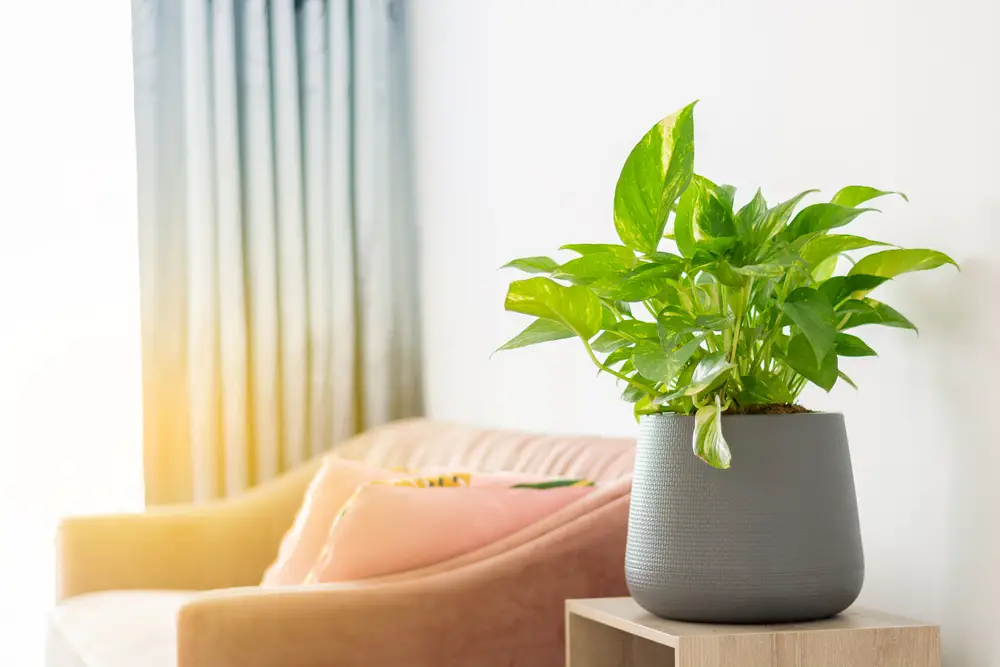
| Origin | French Polynesia |
| Plant size | 20 to 40 inches (50 to 100 cm) long; can trail much longer |
| Flowering | N/A |
| Light | Indirect sun; can tolerate low light |
| Watering | Water when the top inch (2.5 centimeters) of soil has dried out |
| Fertilizer | Feed every 4-6 weeks during spring and summer |
| Potting soil | Well-drained potting mix |
| Pruning | Trim long stems to encourage bushier growth; remove yellowing leaves |
| Repotting | Repot every 1-2 years |
| Toxicity | Toxic to pets and humans if ingested |
Golden pothos is a popular choice for both homes and offices, thanks to its impressive benefits and adaptability.
This resilient plant is renowned for its ability to produce oxygen, contributing to a fresher indoor atmosphere, while effectively removing harmful chemicals such as formaldehyde and benzene.
Thriving in a variety of conditions, golden pothos can flourish in low light and requires minimal care, which makes it perfect for busy office environments.
With its striking trailing vines and numerous health benefits, it enhances well-being in any space.
8. Peace Lily (Spathiphyllum)
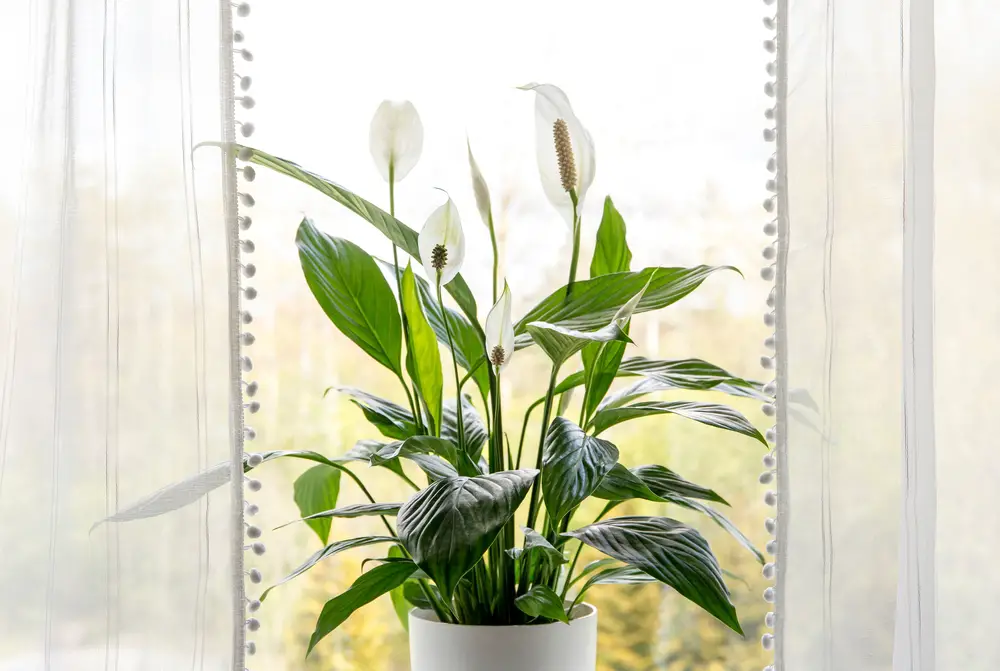
| Origin | Southeast Asia and Central America |
| Plant size | Typically 12 to 36 inches (30 to 90 cm) tall; can spread 12 to 24 inches (30 to 60 cm) wide |
| Flowering | White spathes. Can flower year-round under the right conditions |
| Light | Can tolerate low light. Avoid direct sunlight |
| Watering | Keep soil evenly moist. Water when the top inch (2.5 centimeters) of soil has dried out |
| Fertilizer | Feed every 6-8 weeks during the spring and summer |
| Potting soil | Well-drained potting mix |
| Pruning | Remove yellow leaves and spent flowers |
| Repotting | Repot every 1-2 years |
| Toxicity | Toxic to pets and humans if ingested |
Peace lilies are not just visually striking with their elegant white blooms and lush green leaves, they are also highly beneficial for indoor environments.
They offer a strong oxygen output so they significantly enhance air quality and they purify the atmosphere by filtering out harmful toxins.
Peace lilies are also excellent for adding humidity to the air, which can greatly improve breathing comfort, particularly in drier indoor settings. This combination of air-purifying abilities and humidity regulation makes the Japanese peace lily an excellent choice for creating a healthier and more inviting living space.
9. Weeping Fig (Ficus benjamina)
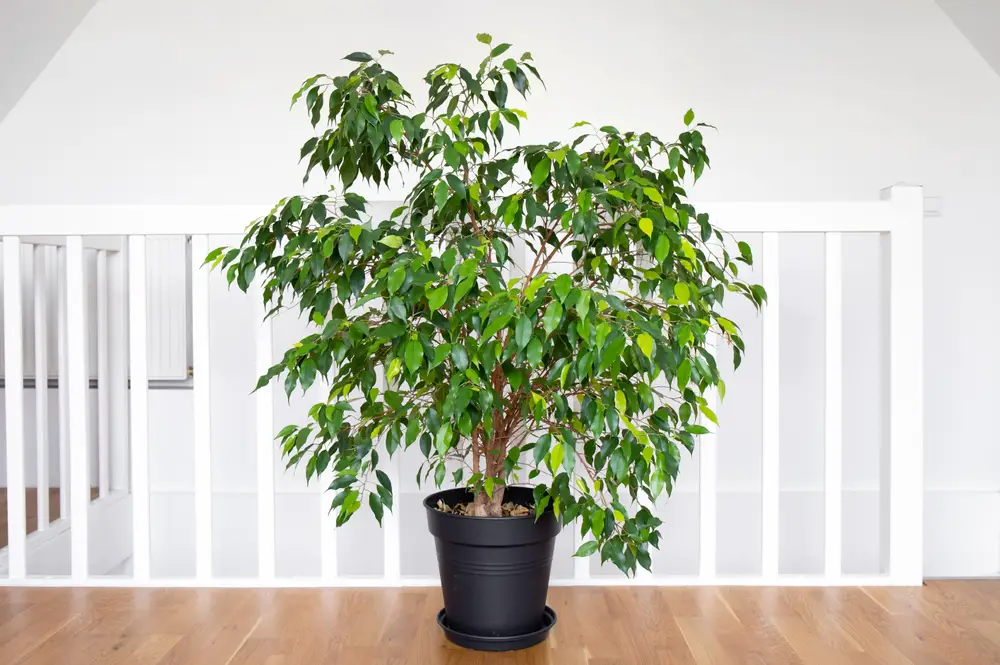
| Origin | Southeast Asia and Australia |
| Plant size | 24 to 60 inches (60 to 150 cm) tall; can spread 24 to 48 inches (60 to 120 cm) wide |
| Flowering | N/A |
| Light | Bright indirect sun |
| Watering | Keep soil evenly moist. Water when the top inch (2.5 centimeters) of soil has dried out |
| Fertilizer | Feed every 4-6 weeks during spring and summer |
| Potting soil | Well-drained potting mix |
| Pruning | Prune to maintain shape and remove any dead or damaged leaves |
| Repotting | Repot every 1-2 years or if root-bound |
| Toxicity | Toxic to pets and humans if ingested. Sap can be a skin irritant |
This elegant plant not only enhances your home decor with its lush, drooping branches and glossy leaves, but it also plays a vital role in improving indoor air quality.
It is a proficient oxygen producer. It also has the ability to filter out harmful gasses such as benzene.
The weeping fig is also known for its easy-care nature. It thrives in a range of light conditions and can tolerate occasional neglect. It’s a great choice for beginners.
10. Areca Palm (Dypsis lutescens)
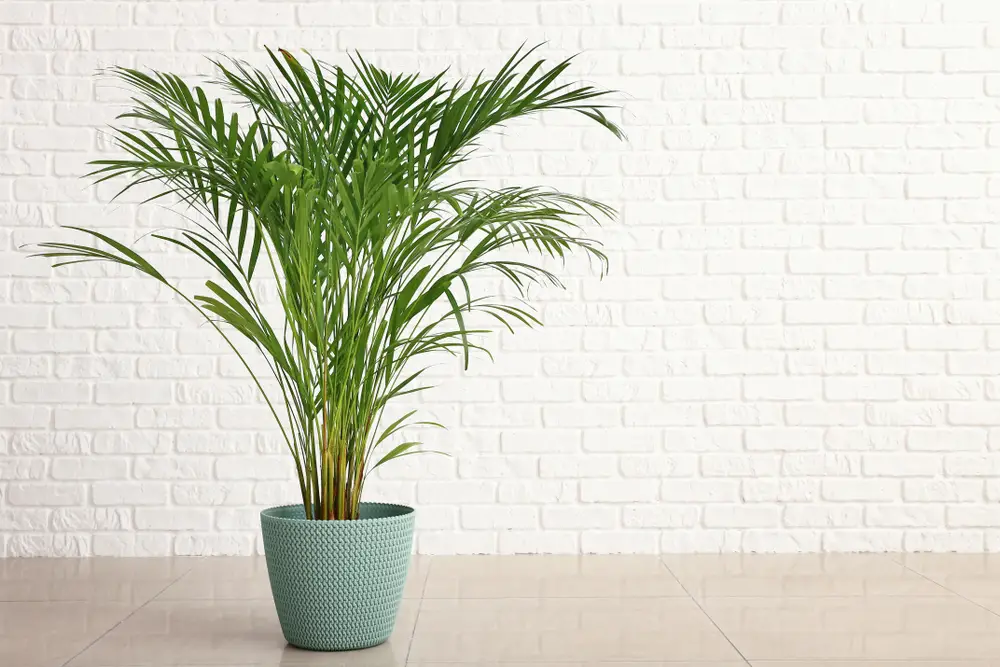
| Origin | Madagascar |
| Plant size | 36 to 72 inches (90 to 180 cm) tall; can spread 24 to 36 inches (60 to 90 cm) wide |
| Flowering | Doesn’t usually flower indoors |
| Light | Bright indirect sun |
| Watering | Water when the top inch (2.5 centimeters) of soil has dried out |
| Fertilizer | Feed every 6-8 weeks during the growing season |
| Potting soil | Well-drained potting mix |
| Pruning | Remove any yellow or dead fronds |
| Repotting | Repot every 2-3 years |
| Toxicity | Non-toxic to pets and humans |
This an exceptional houseplant well-suited for larger living spaces, where its notable height can make a significant impact.
Recognized for its remarkable efficiency in oxygen production, this palm not only enhances indoor air quality but also contributes to humidifying the surrounding environment. It is also effective in purifying the air by filtering out common pollutants.
With its visual elegance and health benefits, the areca palm serves as a sophisticated addition to any home, combining both beauty and well-being.
11. Snake Plant (Sansevieria trifasciata)
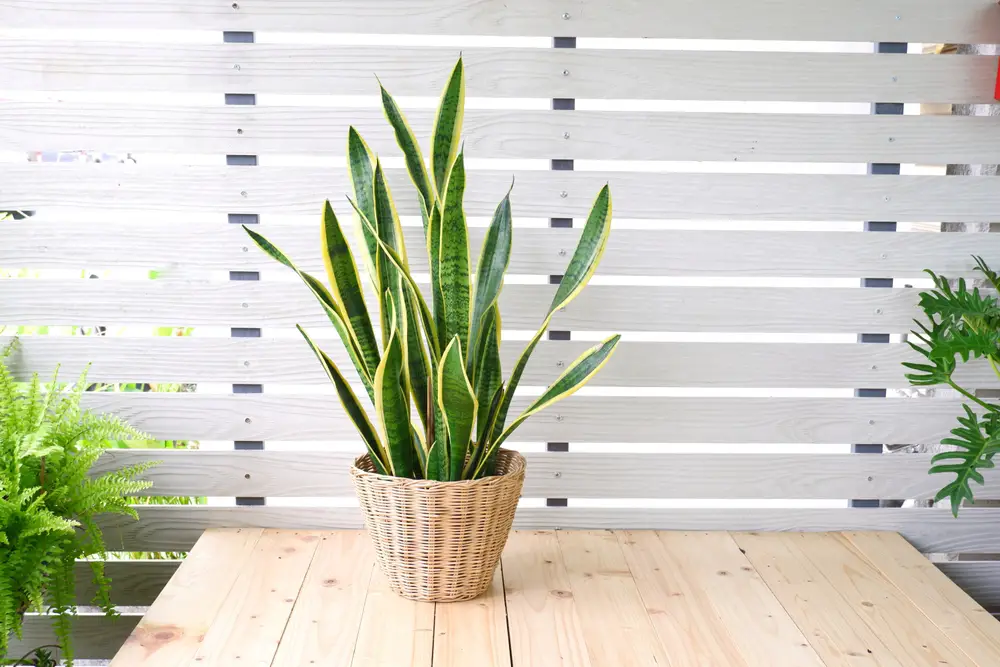
| Origin | West Africa |
| Plant size | 12 to 48 inches (30 to 120 cm) tall; can spread 12 to 24 inches (30 to 60 cm) wide |
| Flowering | N/A |
| Light | Bright indirect sun, can tolerate low light |
| Watering | Allow to dry out completely between watering. Water less in winter |
| Fertilizer | Feed every 6 weeks in spring and summer. Can tolerate little fertilizer |
| Potting soil | Well-draining potting mix; cactus or succulent mix works well |
| Pruning | Remove dead leaves |
| Repotting | Repot every 2-3 years |
| Toxicity | Toxic to pets and humans if ingested |
The snake plant is one of the most popular houseplants. It is known for its striking, sword-like leaves which give it its common name: mother-in-law’s tongue!
One of its standout benefits is its ability to produce oxygen at night, making it a unique choice for bedrooms where clean air is essential for restful sleep.
Additionally, the snake plant is exceptionally low-maintenance, thriving in a variety of light conditions—from low light to bright, indirect sunlight—making it suitable for almost any space. Its hardy nature means it requires infrequent watering, which is perfect for those who may not have a green thumb.
It helps purify the air by filtering out toxins such as formaldehyde and benzene, creating a healthier living environment.
With its combination of beauty, air-cleaning abilities, and easy care, the snake plant is an all-round winner.
12. Money Tree (Pachira aquatica)
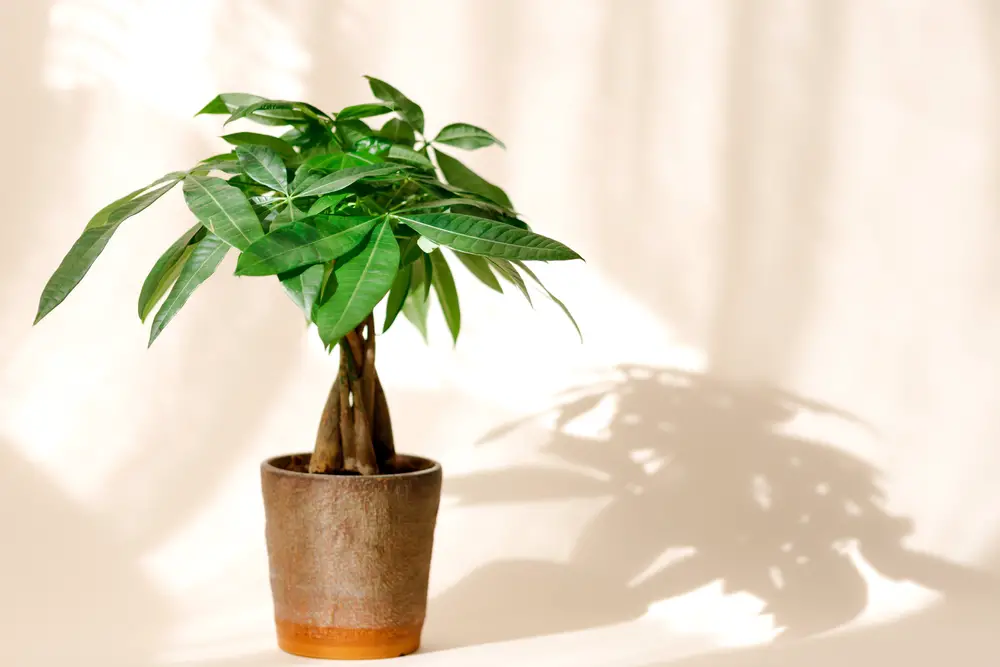
| Origin | Central and South America |
| Plant size | 24 to 60 inches (60 to 150 cm) tall; can spread 24 to 36 inches (60 to 90 cm) wide |
| Flowering | N/A |
| Light | Bright indirect sun, can tolerate low light |
| Watering | Water when the top inch (2.5 centimeters) of soil has dried out |
| Fertilizer | Feed every 4-6 weeks during spring and summer |
| Potting soil | Well-draining potting mix |
| Pruning | Trim any dead leaves |
| Repotting | Repot every 2-3 years |
| Toxicity | Non-toxic to pets and humans |
The Money Tree is a popular houseplant.
It has positive associations in Feng Shui and is believed to attract prosperity and good luck.
Beyond its aesthetic and symbolic value, the Money Tree is an effective oxygen producer, contributing to a healthier indoor environment. Its broad leaves help filter the air, removing toxins such as formaldehyde, benzene, and toluene.
This resilient plant adds a delightful tropical vibe to any space.
13. Calathea Flamestar (Calathea veitchiana ‘Flamestar’)
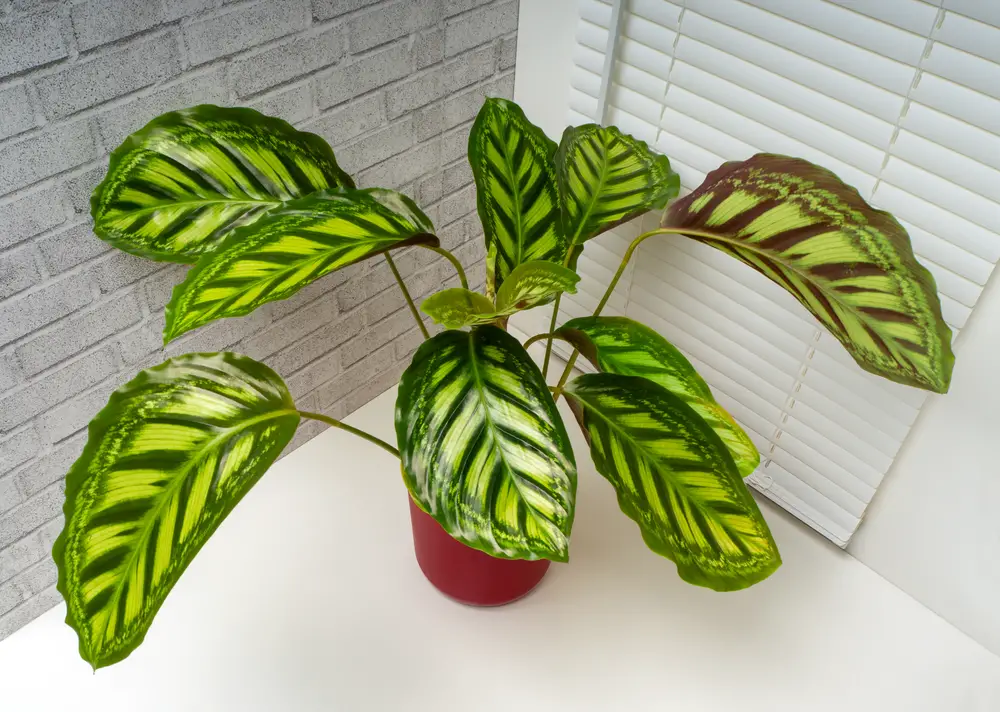
| Origin | Brazil |
| Plant size | 12 to 24 inches (30 to 60 cm) tall; can spread 12 to 18 inches (30 to 45 cm) wide |
| Flowering | N/A |
| Light | Bright indirect sun |
| Watering | Keep soil evenly moist. Water when the top inch (2.5 centimeters) of soil has dried out |
| Fertilizer | Apply general-purpose fertilizer, diluted to half the label recommendations, when the plant is in flower. Stop fertilizing when not in flower in summer |
| Potting soil | Well-drained potting mix |
| Pruning | Remove any dead leaves |
| Repotting | Repot every 2-3 years |
| Toxicity | Non-toxic to pets and humans |
Calathea Flamestar stands out as a remarkable houseplant, not only for its striking visual appeal but also for its numerous benefits.
Its lush, patterned leaves bring a touch of the tropics indoors, making it a captivating addition to any decor. Beyond its aesthetic charm, Calathea Flamestar is known for its ability to produce oxygen.
It thrives in humid environments, which can help increase moisture levels in the air, making it an excellent choice for drier climates. Additionally, this plant plays a role in purifying the air by filtering out pollutants, ensuring that your home feels fresh and revitalized.
14. Orchids (Orchidaceae)
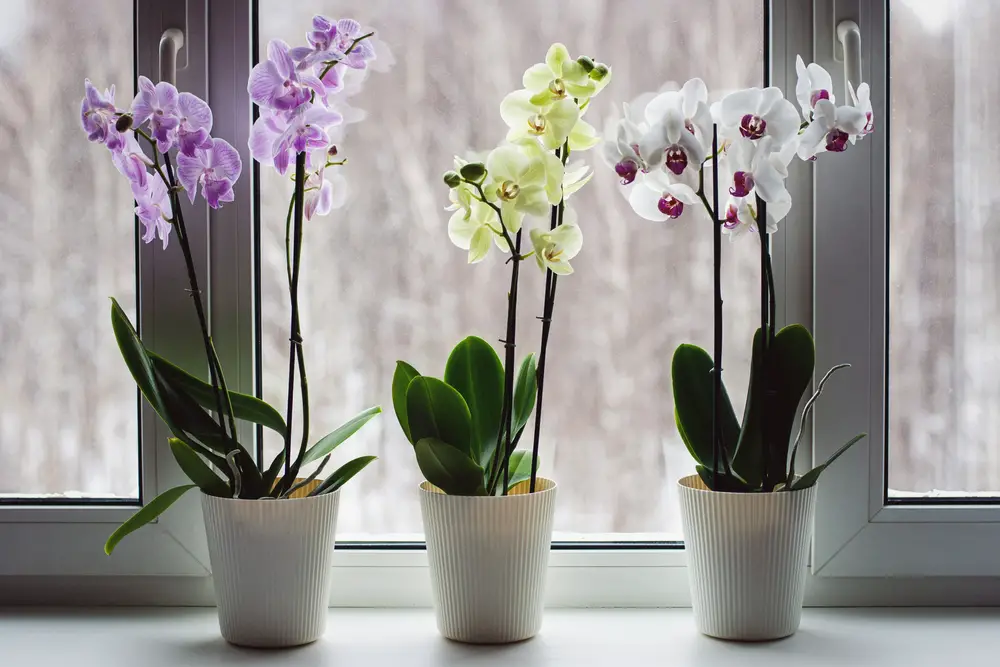
| Origin | Diverse origins; found in tropical and subtropical regions |
| Plant size | Varies. Typically 12 to 36 inches (30 to 90 cm) tall; some species can be much larger or smaller |
| Flowering | Colorful and diverse flowers; flowering can last several weeks to months |
| Light | Bright indirect sun |
| Watering | Water when nearly dry, every 1-2 weeks. Avoid having roots sit in water |
| Fertilizer | Use orchid fertilizer every 2-4 weeks during the growing season |
| Potting soil | Well-draining orchid mix (often bark-based) |
| Pruning | Remove spent flowers and dead leaves |
| Repotting | Repot every 2-3 years |
| Toxicity | Depends on variety, check the details of your specific species |
Orchids may just be the most elegant flower. But they are more than just stunning floral displays; they offer a range of benefits that make them ideal for the home.
These plants effortlessly enhance any room with a touch of sophistication. In addition to their visual appeal, orchids are excellent oxygen producers, helping to purify the air and create a fresher atmosphere.
They thrive best in well-lit areas, making them perfect for bright spaces where their vibrant colors can truly shine. By incorporating orchids into your decor, you not only bring life and beauty to your home but also promote a healthier environment.
15. Tulsi, Holy Basil (Ocimum sanctum)

| Origin | Indian subcontinent |
| Plant size | 12 to 30 inches (30 to 75 cm) tall; can spread 12 to 24 inches (30 to 60 cm) wide |
| Flowering | Small purple or white flowers from summer to fall |
| Light | Prefers full sun – at least 6 hours of direct sunlight |
| Watering | Keep soil evenly moist. Water when the top inch (2.5 centimeters) of soil has dried out |
| Fertilizer | Feed every 4-6 weeks from late spring to fall |
| Potting soil | Well-drained potting mix |
| Pruning | Regular pruning promotes bushier growth |
| Repotting | Repot every 2-3 years |
| Toxicity | Non-toxic to pets and humans |
Tulsi, or Holy Basil as it is commonly known, is not just a cherished herb in many kitchens, it’s also celebrated for its impressive medicinal properties.
Revered in Ayurveda, Tulsi is believed to purify both the air and the mind, making it a vital component of holistic wellness practices. Its aromatic leaves are known to help reduce stress and enhance mental clarity, while their compounds may provide anti-inflammatory and immune-boosting benefits.
Tulsi is a remarkable oxygen producer, contributing to a healthier indoor environment. By incorporating this versatile plant into your space, you can enjoy not only its rich flavors in culinary dishes but also its numerous health benefits that nurture both body, mind, and spirit.
Tips for Buying Houseplants
When shopping in person, it’s important to be sure the plant you’re buying is healthy and in good condition.
Healthy Foliage
Look for leaves that are nice and green, no pale yellow patches or edges (unless the plant is supposed to be multi-coloured!) There should be no dead dry brown tips or spots on the leaves. Be sure the leaves aren’t soft and droopy-looking. Also look for healthy new growth coming in at the tips or base of the plant.
Roots Coming Out The Drain Holes
When a plant’s roots run out of room in a pot, the plant is rootbound (or “pot bound”).
Some plants grow just fine being slightly pot bound but most don’t. If you see roots poking out the drain holes in the bottom of the pot, it’s time for the plant to be re-potted into a larger container.
It doesn’t mean the plant is unhealthy, it just means you’ll have to be prepared to re-pot it when you get it home. Some garden centers offer this service.
